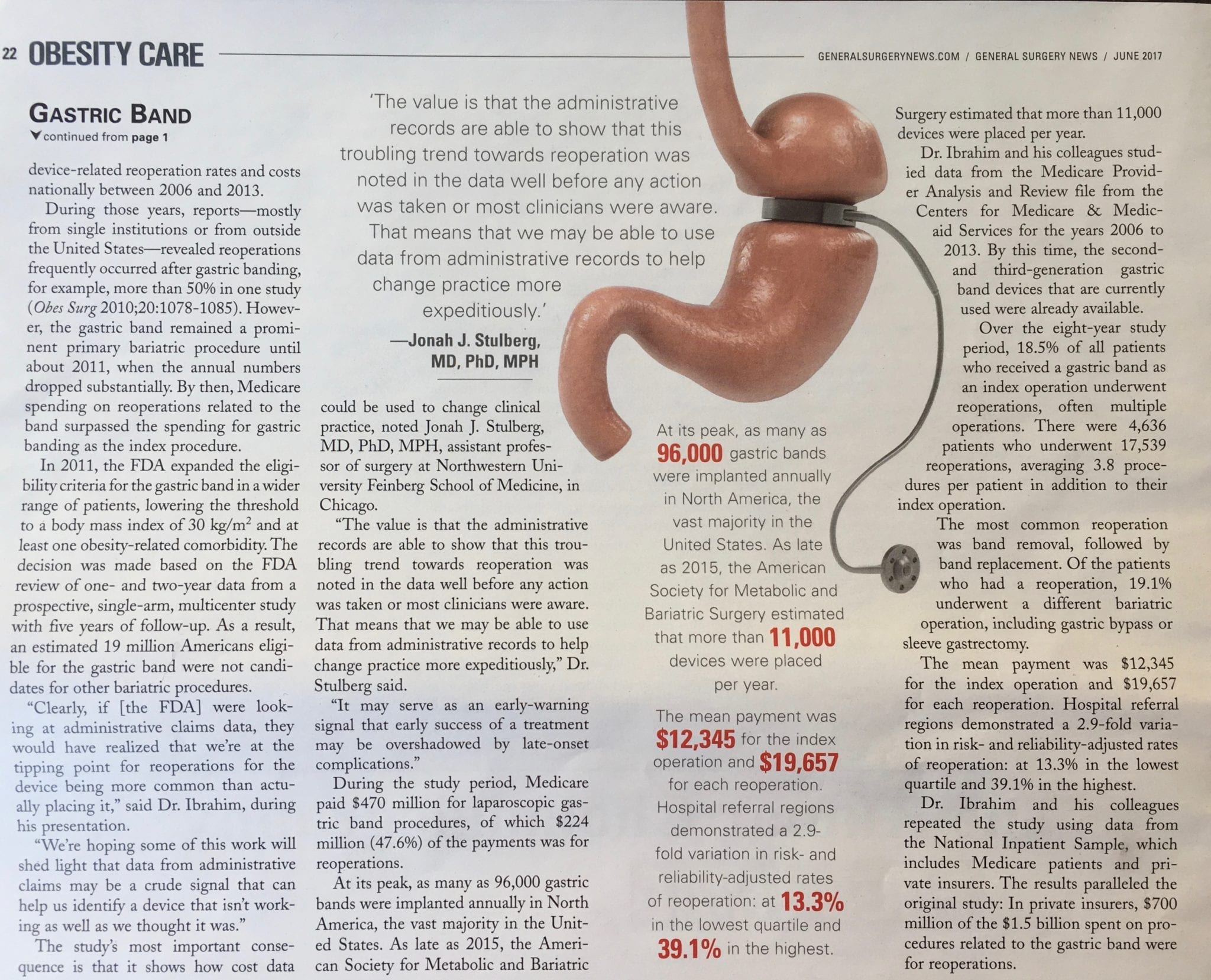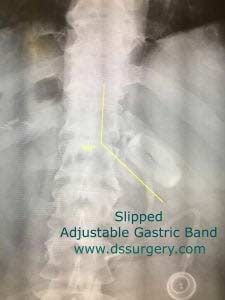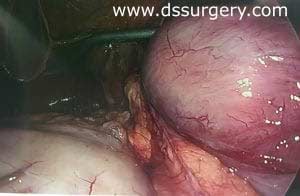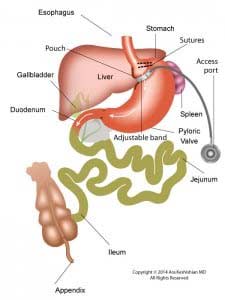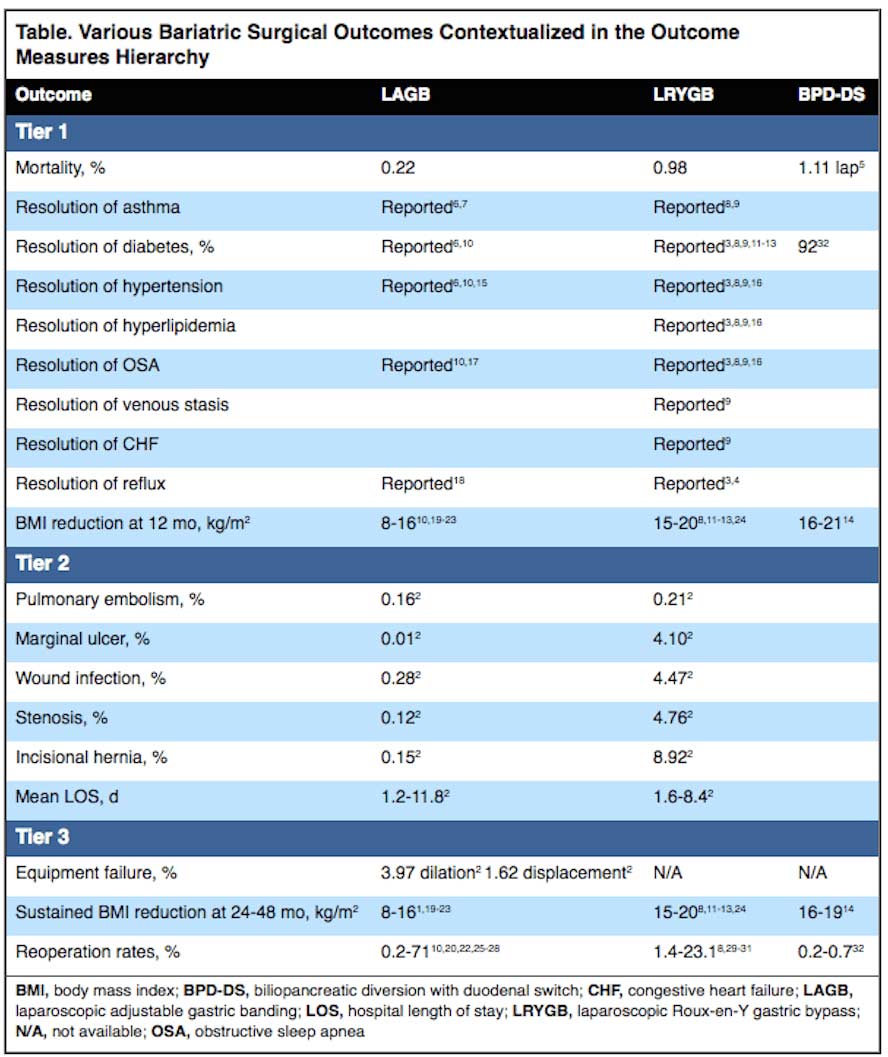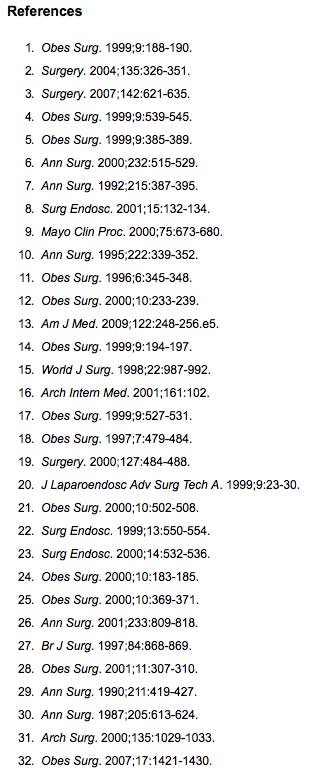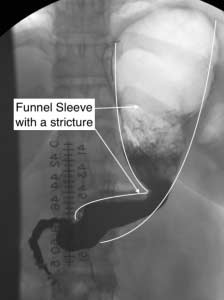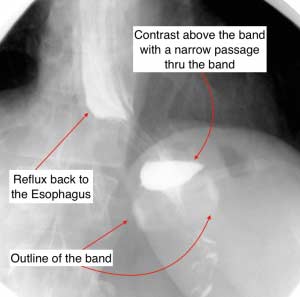Category: AGB
Gastric Band Complications
June 21, 2017 10:22 am
For years, we have seen patients who have had Adjustable gastric bands placed and continue to suffer from the complications associated with it. Gastric Band complications include erosion, persistent nausea, vomiting abdominal pain, inadequate weight loss and weight regain, etc. . Unfortunately, when seeking help, they are often told that this never happens to others and that complications are a rare occurrence. Let’s remember that the Adjustable Gastric Band was promoted and sold as a procedure with almost no down side, low risk and easily revisable!
There is an unfounded expectation that the band can be deflated and all the Gastric Band complications will resolve. This could not be any further from the truth. The reality is that there are patients whose symptoms may somewhat improve but will continue to have the abdominal pain, the nausea and or vomiting-albreit, not to the same intensity. There are several Gastric Band complications that are considered emergency situations that require immediate attention by a physician.
Our position has always been, and continues to be, that all Adjustable Gastric Bands should be removed by a surgeon who is experienced with the Gastric Band complications and revisions.
Slipped Band Emergency
April 27, 2017 12:35 pm
A slipped Band emergency
This patient had a Adjustable Gastric Band (AGB) or LapBand place approximately 7 years ago. The last time this patients had a follow up with the surgeon who placed the AGB was 5 years ago. The patients has been having reflux, episodes of Nausea and vomiting on and off for about 2 years requiring multiple medical visits and procedures. He/she has had upper endoscopies, not by the surgical team and was diagnosed with esophagitis.
This patient presented in the Emergency Room with projective vomiting for 24 hours, bloody emesis, and significant dehydration. After obtaining the necessary tests and X-ray studies a plan was constructed. At this time, due to the continuous and significant nature of the symptoms this patient was taken to the Operating Room for emergency AGB removal.
The abdominal X ray showed a slipped band. Following a complicated surgical procedure, the band was removed and a segment of the stomach that had eroded into the stomach was removed. The photograph below shows the end result with a portion of the stomach removed due to the band’s erosion into the stomach.
Additional information regarding complications of Adjustable Gastric Banding here.
We have several Adjustable Gastric Banding related surgical videos here under the heading of
“Band Related”, including a slipped band emergency video.
Weight Gain after Gastric Bypass
January 04, 2017 9:12 am
Weight loss surgical procedures have different long term results and some procedures have more dramatic weight loss than others. Some procedures also result in much more sustained and long term weight loss. Unfortunately, what may be not obvious is that the patient has very little control over the outcome of the surgery in most cases. IT is very easy to blame the patient for weight regain after weight loss surgery. However, it is important to remind ourselves that the long term data reporting outcomes of the surgical procedures in most cases, includes all patient population. All these studies include the most compliant and not so compliant patients. Comparison chart of outcomes of weight loss surgical procedures.
A larger percentage of gastric bypass patients will require revision for weight regain, or other problems. There is no evidence that the size of the pouch or the anastomosis between the pouch and the small bowel changes the weight regain outcomes. Yet, quite frequently I will see patient who have had gastric bypass revision for weight regain, by reducing the size of the pouch or the anastomosis. Here are some publications that support the notion that other than extreme dilation, the size of the pouch and the size anastomosis does not predict the outcome of the surgery. There is some correlation with the site of the pouch, anatsmosis and weight loss, but there is no correlation between the size of the pooch, the opening and the failure rate. This means that patient with smaller pouch do not have better long term outcome that the ones with larger pouch, only that the patient with smaller pouch or anatsmaosis will loose more weight.
“Influence of pouch and stoma size on weight loss after gastric bypass”
Weight regain after RNY Gastric Bypass may also be caused by a Gastro-gastric fistula, which is a new connection between the pouch and the remnant stomach. Here is further information on Weight Loss Surgery Revisions.
When considering a primary weight loss surgical procedure, be informed. Investigate all your options and consider the long term outcomes. This may mean investigating different weight loss surgical procedures on your own.
Curved Adjustable Gastric Band Discontinued
May 19, 2016 11:19 am
The Curved Adjustable Gastric Band will be discontinued. Johnson and Johnson, the parent company of the Ethicon, is removing the Curved adjustable Gastric Band from its’ product line. This particular band is known as the Realize Band launched by Johnson & Johnson and did not gain much traction. The number of Adjustable gastric band placements have gone down significantly as the data have shown poor outcome over long term and a high complication and re-operative rates.
The following link is a copy of the letter from Ethicon Johnson and Johnson regarding the Curved Adjustable Gastric Bands Discontinuation: Realize Band removed from the Market.
Success Story: Hasmik
January 13, 2016 2:47 pm
Failed Band: My earliest memory of feeling ashamed of being “too heavy” is from kindergarten. For over 30+ years I have struggled with gaining weight, trying to lose weight, or going mad maintaining my weight. There is no shortcut that does not come back to bite you in the butt. There is no diet that effectively changes you permanently. For me exercise is a mindful struggle I sometimes successfully commit to over small periods of time.
I was desperate and ready for a real change. I wanted a genuine difference in the way I consumed and related to food and decided the lap band was the way to go. It was marketed as a “non intrusive, non permanent, easily reversible weight loss tool” and that is EXACTLY what I thought I needed and wanted. I was so very wrong, after my surgery I was considered a “success”. In fact up until the removal of my second slipped failed band, esophagus damage, and poor nutrition; I was considered a success. I look back and think how troubling this was/is. How very damaging to the person struggling and dealing with weight issues. Truly, it messed with my mind and my ability to speak up, admit to myself and out loud the band was NOT working for me. In fact, if I’m completely truthful, it was dangerous and turned me into a residue of the person I once was. I was not able to eat comfortably or eat out any place I happen to be. With the Band, I would need to consider how long I was going to be away from home because I could only eat small bites in small quantities to ensure I did not get stuck or worse vomit what I put inside my mouth. Yes, I had lost almost 100 lbs, but I had given my quality of life as payment. My guilt ensured I would never speak up or complain since I felt “fortunate” and grateful to have had this second chance at life. In my mind, speaking up meant possibly losing the tool (lap band) that allowed me to change my life and reality. Because for the first time in memory, I was the same weight at the start, middle, and end of the year. I did not have to buy different sizes of clothing or underclothing. I could predict what I might wear since my size was stable and my clothes fit. The reality is and was far from this corrupted self truth. I was unhealthy with the restrictive nature of how the lap band worked. In fact my band slipped twice after a severe stomach virus. I later learned of many other symptoms I was making excuses for and quite frankly straight out ignored.
I met Dr. Keshishian (Dr. K) at my lowest weight and at the lowest point in my health. I finally realized, the lap band needed to come out after it had slipped again. It was clear I needed a doctor who would be straight with me and cared for my health and not his/her “success” rates and have the expertise to deal with my failed band. I researched and called several bariatric surgeons then attempted to make appointments with each to discuss the urgent band removal surgery I needed (not as simple as you would think). I was also hopeful I might have the option to undergo the bariatric sleeve surgery because I knew I would not be able to keep my weight under control on my own. I was unwilling to undergo the emotional and mental torment of gaining and losing weight for the rest of my days. I succeeded in making three appointments and truthfully after meeting and speaking to Dr. K and his office staff I canceled them immediately. Let me start with the staff as that REALLY is important; they help you feel comfortable with the doctor, the procedure, and overall experience. They represent and reflect how the doctor you’re about to see will treat his patients. The expected standard within Dr. Keshishian’s office immediately made me feel like I called the right place. I was taken by the knowledgable, kind tone and efficient manner in which they requested the necessary information to effectively help me get from the starting point to the end goal. When I got to my appointment, Dr. Keshishian BLEW MY MIND. He not only presented himself as an approachable person I immediately felt at ease with but also reveal my concerns and questions. He treated me like a person. This may sound strange but this doctor made me feel like a human being with real concerns. He listened to me, asked questions rather than talked at me, and explained how and what was happening to my body and mind. He spent 3 hours with me to answer all my questions (even if I repeated them), draw diagrams, show me video to better help me understand what was happening, and then just sat with me while I cried for a moment. I cried because my 30+ years journey of ups and downs, crazy and insanity finally led me to the door of a man who understood and knew how to help without judgment. WHICH DOCTOR DOES THIS! None that I know.
My life post surgery is what I always hoped it would be. I am able to eat vegetables, leafy greens, fruit, grains and basically a well rounded diet. What’s amazing is that I naturally do not crave sweets, heavy creamy dressings, sauces and fill up quickly. There is after all a difference between the restriction of a lap band and the feeling of being full with the sleeve which Dr. K patiently explained. Today I am able to go any where, at any time, enjoy the moment and the company rather than worry about what I’m not able to consume. My days of scanning to locate the nearest bathroom in case I need to dash to it are over.
As I write this today, I feel like a real person, not some transient hoping to savor my life at glimpses. I am a person that is balanced in my heart with the average person’s anxiety and mindful eating habits. The sleeve is not a magic end to weight gain, it does give you the fighting chance to make choices in life leading up to results you’re willing to work for.
~ Grateful and Mindful, Hasmik (September 2015 Sleeve Op Patient)
2015 ASMBS Summary
November 11, 2015 7:31 am
The 2015 ASMBS meeting was held November 2-6, 2015. It was combined with TOS (The Obesity Society) and had more than 5,600 attendees from all over the world in every aspect of obesity treatment. There were some interesting additions and deletions from this meeting compared to the past.
The one sentence that comes to my mind is “I told you so”.
One important addition was a DS course for Surgeons and Allied Health. This was very exciting, except the content and questions seemed to gravitate to SADI/SIPS/Loop rather than DS. Dr. Cottam was one of the moderators of the course. It seems that they have found the value in preserving the pyloric valve. It was clear that the discussion was driven by the need to come legitimize the single anastomosis procedures at this early stage with almost no data to prove long term outcome. With many of the Vertical Sleeve Gastrectomies having re-gain and the they are looking for a surgery that the “masses” can perform. This was actually the term used by one of the presenters, implying that the duodenal switch needed to be simplified so that all surgeons, those who have pushed all other procedures can not offer Duodenal Switch to their patients with less than desirable outcome. Several surgeons also voiced their concern and dissatisfaction with the issues and complication of the RNY and want an alternative. There was much discussion regarding SADI/SIPS/Loop being investigational and that it shouldn’t be as it is a Sleeve Gastrectomy with a Billroth II. Dr. Roslin and Dr. Cottam discussed their SIPS nomenclature saying they wanted to stay away from something that had Ileostomy, suggesting bowel issues, or the word “SAD”i due to negative connotations. The point to be made is that the SADI and SIPS and the loop are all the same. I have also noticed other surgeons using SADS (Single Anastomosis Duodenal Switch). There is a great deal of industry behind these procedures and many surgeons being trained in courses funded by industry. One surgeon stood up and informed the entire course that they need to be clear with their patients about the surgery they are performing, as he had been in Bariatric chat rooms and there is upset within the community about SADI/SIPS/Loop being toted as “the same or similar to Duodenal Switch”.
There was also presenter who said “We are doing something new about every five years.” No, “we” are not. Some of us have stood by the surgery and techniques with the best long term outcomes and not gone with every “new” thing out there. The process of Duodenal Switch may have changes, open Vs. Lap, drains, location of incisions, post operative care and stay, but the tested procedure with the best outcome has been the duodenal switch operation and not the shortcut versions. Although, those of us that are standing by long term results seems to be in the minority. Why do I stand by Duodenal Switch? Because it works, when done correctly by making the length of the bowel proportional to the patient total bowel length, and height, and not just cookie cutter length for all patients, with the right follow-up, patient education, vitamin and mineral regime and eating habits.
A new addition was the Gastric Balloon, which in the research presented had a 60-70% re-gain rate and a no more than 10-15% weight loss one year only. This data represents more than 70% weight regain when the balloon is taken out. The Gastric Balloons can be left in between 4-6 months depending on the brand or type of balloon. The Gastric Balloon is not new to the Bariatrics and was first introduced in 1985. After 20 years and 3,608 patients the results were and average of 17.6% excess weight loss. It seems that we are re-gurgiating old procedures. There are many new medications that were front and center in this meeting.
The Adjustable Gastric Bands were missing from the exhibit hall this year. It is my hope and feeling from the other attendees that we may be seeing the era of the Adjustable Gastric Band being placed in patients come to an end. Although there are some still holding out that there are some patients that can do well with the Band.
Attending the 2015 ASMBS meeting this year, as it has every year, only reemphasized the importance of avoiding what has become the norm of chasing a simple solution that is fashionable and easy now. We stay convinced that the duodenal switch operation with the common channel and the alimentary length measured as a percentage of the total length is by far the best procedure with the proven track record. The patient should avoid the temptation of settling for an unproven procedure or device, because if history holds true, there will be a need for revision surgeries in the future.
Surgical Outcomes
October 02, 2015 10:10 am
In a recent review article published in the September 2015- Volume 42:10 of General Surgery News, the surgical outcomes of different procedures were summarized. There were evaluated based on a number of measures, including re-operation rates. So interesting to note that the re-operation rate of the duodenal switch is the lowest of all surgical procedures.
Adjustable gastric banding had the highest reported re-operation rate. To be noted is the longer the time lapse the higher the need for re-operation for the band.
Original article here.
Failure of Anti-Reflux Procedures
September 28, 2015 7:13 am
A recent study Published in JAMA Surgery, quoted rate of 10-20% of patients who have had anti-reflux surgical procedures will have recurrence of his symptoms within the research data. There are numerous studies that have identified predictive factors leading to return of the symptoms after surgical intervention. Some of these predictive factors are improper diagnosis, inadequate work up and technical issues.
Due to the significant rise of sleeve gastrectomy as well as a high failure rate of the lap band, we have seen several patients presenting with significant reflux disease after weight loss surgery. There is a little scientific data regarding the failure of anti-reflux procedures in patients who have had previous weight loss surgical operations. In our practice, however, we have extensive experience with anti-reflux operations in patient who have had previous weight loss surgeries including Gastric Bypass, Adjustable Gastric Banding, Sleeve Gastrectomy and Duodenal Switch operation.
Improper diagnosis, inadequate work up, and technical issues have been cited as possible causes for recurrence of symptoms in patients who have not had weight loss surgery. One could assume that those variables are still a factor in addition to other factors resulting from a previous weight loss surgery. The complications of a previous weight loss surgery can not be under-estimated; an example would be a patient with significant esophageal motility issues directly related to an Adjustable Gastric Band. Other situations that exacerbate symptoms of reflux are an hour glass shaped sleeve or a stricture mid stomach post Sleeve Gastrectomy or Duodenal Switch.
In our experience, some patients have responded well with anti-reflux surgical procedures and mesh placement if indicated after a compete work up with has included and upper endoscopy, upper GI series, manometry and Ph studies. Any patient with symptoms of reflux after weight loss surgery, should be evaluated, and a complete work up should be performed to establish the proper treatment options. It is not wise to have patients be treated with proton pump inhibitors as a default treatment without a complete work up for any patient with reflux. These class of medications have significant side effects associated with them. Furthermore, prolonged reflux is a factor in development of Barret’s Esophagus, a pre-cancerous condition.
Alcohol and Weight Loss Surgery Webinar May 20, 2015
July 27, 2015 7:27 am
Band Removal Revision to Sleeve Gastrectomy
July 06, 2015 11:49 am



